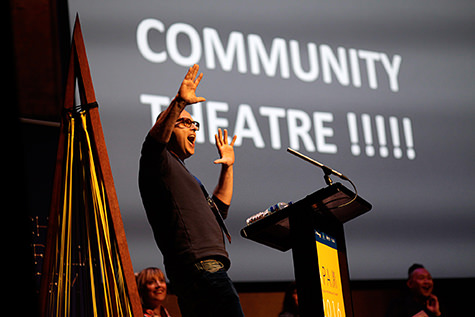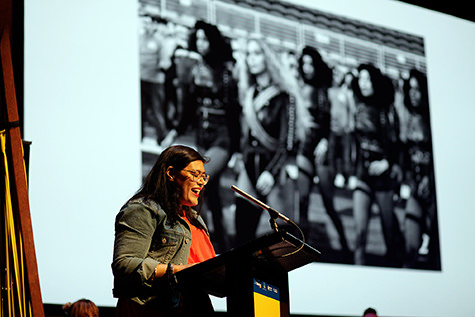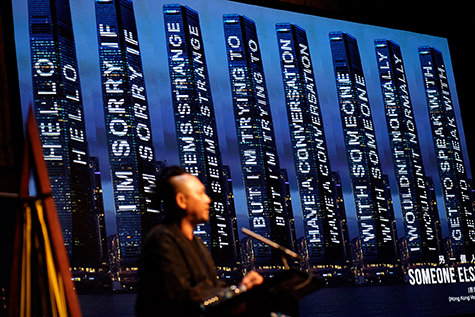 |
Darren O’Donnell, APAM keynote speaker photo FenLan Chuang |
In gauche terms, APAM is a place where people buy and sell art. Unlike at Sotheby’s Australia, however, the bids are silent and there are costumes; it’s just a bit more fun. This year, running alongside the pitches and presentations, was The Exchange program, a series of panel sessions and less formally curated “encounter” opportunities, aimed at encouraging “new relationships and new dialogues” among delegates.
One of the event’s hosts, Kris Stewart, Brisbane Powerhouse Artistic Director, who dubbed APAM the “Air-conditioned Performing Arts Market” (an apt descriptor considering the event was held in Queensland’s high summer), confirmed that the conference is a pretty big deal these days; the opening keynote was attended by 650 guests from 30 nations. Hosted by Wesley Enoch, four artists and cultural leaders were invited to offer provocations to the gathered buyers and sellers of art.
The keynoters
Willoh S Weiland, Artistic Director of Melbourne’s Aphids, the first of the keynote speakers, was particular about setting some terms for the assembled players, those gathered to participate in this week-long “glittering swamp of culture.” For Weiland, the notion of a marketplace implies openness and transparency, although she acknowledged the potentially different experiences of the buyer and seller in this context. Presenters were likened to “smiley, bright-eyed Christians let loose on a speed date,” while artists were described as “pale with the existential trauma of talking about their art.” Weiland wrapped up with the sage advice that presenting partners, once in a relationship with artists, should honour their commitments: “Don’t be a jerk, call when you say you will.”
Darren O’Donnell, Artistic Director of Canada’s Mammalian Diving Reflex, the highly successful performance collective who brought Haircuts by Children to Australia and All the sex I’ve ever had to the 2016 Sydney Festival, works with non-professional performers. Comparing himself with mainstream artists, he described himself ironically as “a community loser,” and proud of it. According to O’Donnell participatory performance is the future. Likening his practice to “social acupuncture,” O’Donnell makes a case for recruiting non-performers while maintaining rigour throughout the creative process through curatorial considerations and the development of an agreed performance ‘script.’ O’Donnell sees this type of work as a rich contrast to the “hermetically walled-off works” regularly programmed.
 |
Nakkiah Lui, APAM keynote speaker photo FenLan Chuang |
Kee Hong Low, the final presenter and current Head of Artistic Development for Hong Kong’s West Kowloon Cultural District Authority picked up the thread through each speaker’s provocations. Persuasive in his quiet insistence that we all carry prejudice within, his challenge to us was to consider that art is not found in big revolutions or grand gestures, but in our everyday engagement with others.
To illustrate his message, the artist gave an example of a recent work, initially installed in a cultural institution as an epitaph in stone challenging passersby to say hello and start a conversation. Later these same words were projected onto some of Hong Kong’s tallest corporate buildings, lighting up the night skyline, an unmissable example of art and activism. Kee Hong Low finished by encouraging each of those attending to take up the challenge of speaking to someone completely new to them at this year’s APAM and to consider the broader impacts of these transactions over the conference and beyond.
 |
Kee Hong Low, APAM keynote speaker photo FenLan Chuang |
Zoom In: On…
A second stream to the Exchange program at APAM was the Zoom In: On…series, including sessions around Theatre for Young Audiences and Circus and Physical Theatre in Australia. The former was a breakfast gathering for theatre makers of works for children.
Much of the conversation centred on content, that is, making works for young people straddling the artistic and popular divide. For many delegates this begged the question, how do you get audiences to come to works other than adaptions of well-known picture books? Peppa Pig, that snub-nosed juggernaut of children’s television, it was widely agreed, “is a scourge.”
Another concern was the perception that children’s theatre tickets should be priced lower than those for works targeted at adults, an issue “systemic across the industry.” This disparity is odd, given that children’s theatre does not cost any less to make. And it is often the venue that bears the brunt of the shortfall, making it more difficult for presenters to take risks on new and original works.
As expected, given the format (a bunch of adults talking about what children should go and see), the question of relevance invariably came up: so what do the kids think? Perhaps Willie White, the Artistic Director of Dublin Theatre Festival summed it up best when he observed that the theatre maker should always consider “Who is the child you have in mind for this work?” An excellent provocation to munch on over your Coco Pops before moving onto the grown-up business of buying and selling art.
At the Circus and Physical Theatre in Australia session hosted by Yohann Floch, from the Fresh Arts Coalition Europe, participants were asked to respond in groups to two key questions: What is success for your organisation? And, what is success for your sector?
Throughout the impassioned discussion, a number of sector issues were perceived as current barriers to success. For instance it was felt by some in the room that ‘physical theatre,’ as a genre and a term, has had its day. Also cited as a concern was the rise of “circus missionaries.” As means to generate extra income, companies are taking circus training overseas, particularly to developing countries. As a result, circus is being introduced to places where there are already rich performative traditions linked to local cultures. The offer of skills exchanges was held up as a more desirable model.
The prevailing view from international APAM delegates was that Australia is a world leader in contemporary circus presentation and touring. Some exciting factors were identified as desirable: getting networks more connected globally to assist with touring opportunities; pursuing further dialogue with government regarding an appropriate funding model; establishing a dedicated circus festival (in the vein of events like Dance Massive); improving on the “tights and lights” model—still a cost-effective way to get circus touring locally; and shifting class perceptions around circus—getting shows out of tents and onto mainstages.
Yohann Floch summarised the morning’s work by affirming that ‘group-think’ had yielded some great innovations. He then threw down a new challenge: who would be responsible for putting these into action, an idea is only as successful as its execution.
First Nations’ Perspectives
Speaking of action, apparently the first thing panelists did at the First Nations’ Perspectives session was reorganise the chairs. Moving them from a straight line on the stage to a curve, ensured that the speakers and host Lydia Miller of the Australia Council for the Arts were able to interact throughout the ensuing conversation, which was based around Australia’s relationship to indigenous art and culture as seen through and with international eyes.
For each of the panelists “framing new cultural narratives in the 21st century” presents a number of challenges. Ryan Cunningham of Canada’s Native Earth spoke of the need for artists and presenters to avoid producing the museum-like diorama pieces of the past: works where a culture is “preserved as though behind glass.” For Santee Smith, of Canada’s Kaha:wi Dance Theatre, to move “beyond the fractures” and “decolonise art,” artists, cultural organisations and governments must employ a “re-” approach. For Smith, “A reconsideration, a reframing and a reconstruction (rather than deconstruction)” will ensure a move towards new and relevant cultural narratives and works.
Rachael Maza of Australia’s own pioneering ILBIJERRI Theatre Company expresses the view that “art for its own sake is a waste of money.” Instead for Maza, art at its best is always driven by provocateurs, “those wooden spoons of society.”
One of the next challenges, the panelists agreed, was the claiming of performance spaces. Black box theatres “have a code, with ways of operating within them.” The question for these artists then was “how can we turn these spaces into ours?”
Hone Kouka, of New Zealand’s Tawata Productions, acknowledged by the other panelists as a leader in creating opportunities for First Nation performance works, noted the changes to APAM programming over the last 15 years, with a significant increase in First Nation delegates attending. “I’m loving the shift,” he said.
Me too, and judging by the bright smiles and thrum of conversation in the foyer spaces, artists, producers and presenters were taking Kee Hong Low’s advice and making friends, as well as deals, at this year’s APAM.
APAM, Australian Performing Arts Market, Exchange Program, Brisbane Powerhouse and other venues, 22-26 Feb
RealTime issue #131 Feb-March 2016 pg. web
© Victoria Carless; for permission to reproduce apply to [email protected]








 back
back